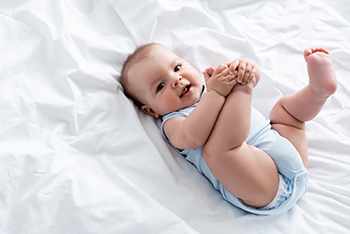
A congenital foot problem is one affecting the feet, toes, or ankles of newborns. Such problems include clubfoot, vertical talus, tarsal coalition, polydactyly, macrodactyly, and cleft foot. These afflictions can have various causes, but some are genetically based on someone in the family having a gene causing the condition. Others can simply be an anomaly. A few of these conditions are described here. Clubfoot is when the tendons of the foot shorten, the bones are of an unusual shape, and the Achilles tendon is tight, causing the foot to point inward and downward. The soles of the feet might also face each other. This condition typically affects both feet. If not treated, a child will walk on the sides of their feet and ankles. Polydactyly is when the child has more than five toes on one or both feet. Usually, a nubbin or small lump of tissue without a bone or joint will be present. Macrodactyly is when the toes are abnormally large due to the overgrowth of the underlying bone or soft tissue. Having this condition makes it harder for a child to use the affected foot in all activities. Cleft foot is rare and occurs when the foot is missing toes, a V-shaped cleft, or other anatomical differences. The main issues are whether a cleft foot can fit into a shoe, as well as the shape and appearance of the foot. If you have a child born with a congenital foot problem, consult with a podiatrist to see if any treatments or surgery is recommended to help your child continue life most comfortably.
Congenital foot problems require immediate attention to avoid future complications. If you have any concerns, contact one of our podiatrists of Foot & Ankle Associates of Maine. Our doctors can provide the care you need to keep you pain-free and on your feet.
Congenital foot problems are deformities affecting the feet, toes, and/or ankles that children are born with. Some of these conditions have a genetic cause while others just happen. Some specific foot ailments that children may be born with include clubfeet, polydactyly/macrodactyly, and cleft foot. There are several other foot anomalies that can occur congenitally. What all of these conditions have in common is that a child may experience difficulty walking or performing everyday activities, as well as trouble finding footwear that fits their foot deformity. Some of these conditions are more serious than others. Consulting with a podiatrist as early as possible will help in properly diagnosing a child’s foot condition while getting the necessary treatment underway.
What are Causes of Congenital Foot Problem?
A congenital foot problem is one that happens to a child at birth. These conditions can be caused by a genetic predisposition, developmental or positional abnormalities during gestation, or with no known cause.
What are Symptoms of Congenital Foot Problems?
Symptoms vary by the congenital condition. Symptoms may consist of the following:
- Clubfoot, where tendons are shortened, bones are shaped differently, and the Achilles tendon is tight, causing the foot to point in and down. It is also possible for the soles of the feet to face each other.
- Polydactyly, which usually consists of a nubbin or small lump of tissue without a bone, a toe that is partially formed but has no joints, or an extra toe.
- Vertical talus, where the talus bone forms in the wrong position causing other bones in the foot to line up improperly, the front of the foot to point up, and the bottom of the foot to stiffen, with no arch, and to curve out.
- Tarsal coalition, when there is an abnormal connection of two or more bones in the foot leading to severe, rigid flatfoot.
- Cleft foot, where there are missing toes, a V-shaped cleft, and other anatomical differences.
- Macrodactyly, when the toes are abnormally large due to overgrowth of the underlying bone or soft tissue.
Treatment and Prevention
While there is nothing one can do to prevent congenital foot problems, raising awareness and receiving neonatal screenings are important. Early detection by taking your child to a podiatrist leads to the best outcome possible.
If you have any questions please feel free to contact our office located in Brunswick, ME . We offer the newest diagnostic tools and technology to treat your foot and ankle needs.
